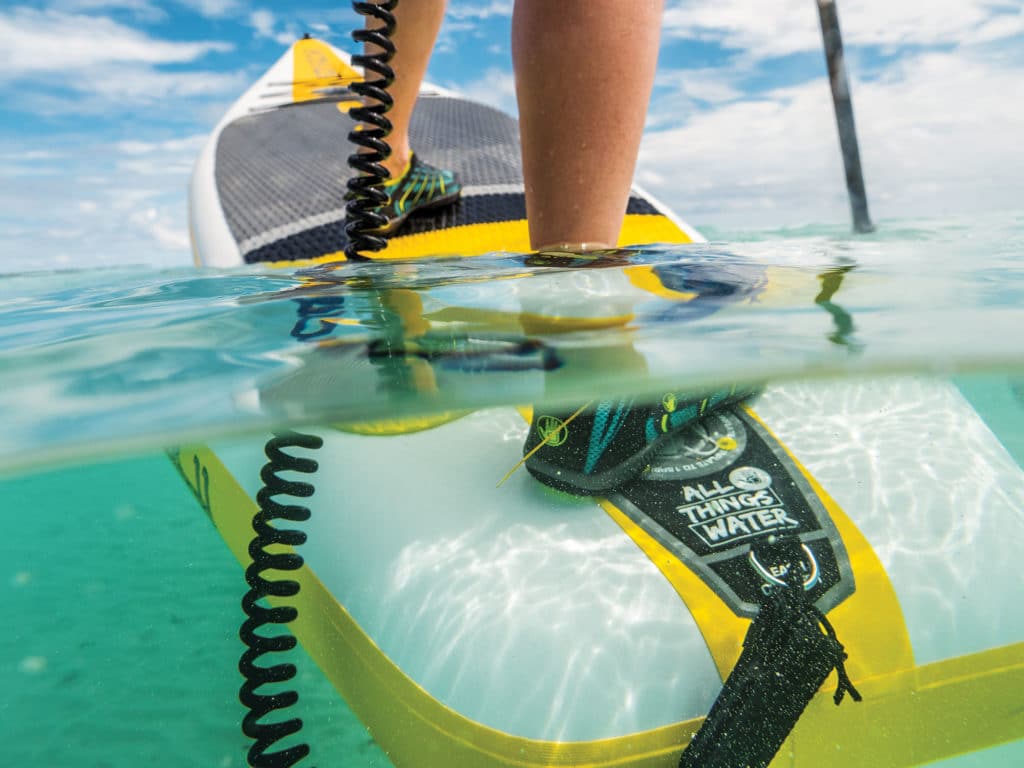
Luke Hopkins was about to take on one of the most extreme stand-up paddleboard adventures of his life, and it was snowing.
Hopkins, a SUP expert with 20 years of experience, had decided to take on Lava Falls in the Grand Canyon, a historic achievement in paddle sports. Fortunately, he’d come prepared. “I had on a drysuit and life jacket, shoes and a helmet,” he said of his run in the epic white water. “I had the time of my life, and it was super fun, but I took every measure to stay safe.”
Safety is something many people take for granted while enjoying the increasingly popular SUPs, which can be found in many recreational boaters’ arsenals. Thanks to board racks, dedicated stowage spaces and inflatable SUPs, boaters increasingly bring them on board. But a lot of people don’t appreciate the dangers of a SUP. The Coast Guard reported that paddle-sports fatalities — including those in canoes and kayaks — have been on the rise, including 15 SUP-related deaths in 2016.
Most of these incidents are not in extreme situations (like running Class V rapids) that professionals such as Hopkins undertake. They are otherwise safe trips where a paddler goes unprepared.
“If you follow a few basic safety practices, you can keep alive and well on a paddleboard for life,” says Hopkins.
The number one most important safety practice: wear a life jacket. Why? In 14 of the 15 reported SUP fatalities in 2016, the victim was not wearing one. Every reported SUP incident, even the nonfatal ones, involved a rider falling and getting separated from his or her board. “If you fall off a paddleboard and it gets caught in the wind, you can’t swim fast enough to catch up to it,” says Hopkins. “Without a life jacket, you’re in trouble.”
If you are able to recover your board, the buoyancy a life jacket provides makes it easier to climb back aboard. Of course, chasing a board wouldn’t be as much of an issue if people practiced the second most important tenet of SUP safety: wearing a leash. The leash is a flexible tether that attaches to the back of the board and around one of your ankles, keeping you connected even if you fall. But even if you use a leash, it’s still important to wear the life jacket.
“I’ve had leashes break and boards break,” says Hopkins. “Do you really want to stake your life on a strap around your ankle?”
Hopkins also preaches to wear appropriate gear: wetsuits, or even drysuits in cold weather conditions, helmets in rough water where rocks could be present, and shoes. You don’t want to fall off your board and risk cutting your feet on rocks, oyster beds or other sharp objects.
What other safety practices does Hopkins suggest? If possible, paddle with a buddy. It’s always good to have someone else around should something go awry. And always tell someone else when and where you are going. If you get into trouble and no one knows you’re missing, no one will come to help.
Take the right safety precautions and you’ll enjoy your SUP time on the water — maybe not running rapids in the Grand Canyon, but at least paddling the local cove with your kids.
Is a SUP a Boat?
Many boaters want to know: Is the SUP in their arsenal of toys actually a boat? The answer is yes, depending on where you use one. The Coast Guard has stated that unless used in a swimming, surfing or bathing area, a paddleboard “is a vessel under 46 U.S.C. 2101 and therefore subject to applicable regulations administered by the U.S. Coast Guard.” This means SUP users, unless on or near the beach, are subject to the same safety and navigation rules as regular boaters.









